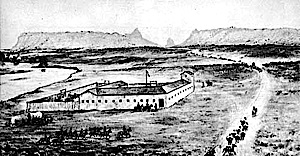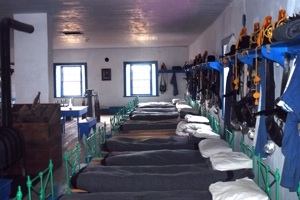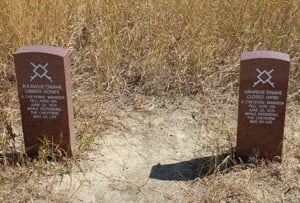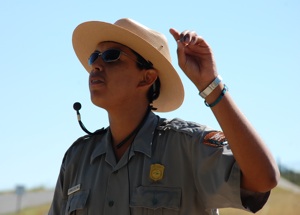Editor's note: Earlier this year we ran a story by former Park Service historian Richard West Sellars that examined how fully the National Park Service at Fort Laramie National Historic Site recounts the history of the 19th Century Indian Wars. The following article from Robert Pahre, a political science professor at the University of Illinois, Urbana-Champaign, takes a broader look at how the National Park Service interprets Native American history. The article first appeared at Indian Country Today.
National parks are America's great outdoor classrooms, and they attract about 300 million visitors a year, from school groups to senior citizens, mountain climbers to families in minivans. The vast majority of those people will flip through the park's brochure, browse exhibits at in the visitor center, and read some of the informational signs posted at the roadside turnouts.
The more organized or ambitious of the visitors perhaps even checked out the park's website before they came. In all those venues the National Park Service interprets the site for visitors, teaching them about the park and why it is important. That adds up to a lot of history, a lot of stories. There are stories about the American Revolution in Boston and Philadelphia, about the Confederacy on Civil War battlefields, about segregation along the Selma to Montgomery National Historic Trail, about pioneers and Indians along the monuments to Western Expansion.
The parks that preserve wild nature, such as Yellowstone, Yosemite or the Everglades, also tell a lot of historical stories. Even a national recreational area or seashore like Lake Mead or Fire Island will interpret the area's history for visitors on their way to those beaches.
Because American Indians lived everywhere in this country, the NPS could tell Native stories at almost every site. After all, it has chosen to tell the stories of settlers at most park units. Unfortunately, the NPS usually leaves out the Native stories in the parks, letting Indians vanish from most park landscapes.
Too much of the NPS's interpretation of our history is incomplete, and it usually leaves out the Native stories. And when it does tell a Native story, all too often, it is through the eyes of other people, the way it has been done it in too many movies.

Native Americans, such as these at Fort Laramie, played key roles in the country's history, but how well does the National Park Service tell those stories?
In Dances With Wolves, for example, Kevin Costner portrays the Lakota sympathetically, but through the eyes of a white military man who falls in love with a white woman who had been adopted by the tribe.
A less benign example of that can be found at Indiana Dunes National Seashore, which tells of the Potawatomi tribe through the experiences of a white man, Joseph Bailly. A sign at the Bailly homestead explains that he bought beaver furs and other items from the Potawatomi in exchange for various trade goods. Another sign says the United States gave Bailly $6,000 for counseling the Potawatomi when they sold their land in the Chicago Treaty of 1833.
That was a huge sum of money back then, but the sign doesn't say what he did in those negotiations that made the U.S. government so grateful. Nor does the sign finish the story'the Potawatomi ended up on a 'Trail of Death' westward, across the Mississippi.
That's just one of many Native stories the NPS leaves out of its narrative. Drive across the Great Plains and visit the park units there. Except for Minnesota's Pipestone National Monument and Knife River Indian Villages in North Dakota, the national park units on the Plains focus on a short period of settlers' history instead of the much longer Native histories. They also tend to talk about the deeds of settlers instead of the impact those actions had on American Indians.
Visitors to Nebraska's Scotts Bluff National Monument see a replica covered wagon along with part of the original Oregon Trail as it heads through Mitchell Pass. Across the parking lot, the Oregon Trail Museum and Visitor Center tells the story of the emigrants who passed this way. The American Indians who lived here appear in an exhibit entitled, 'The White Emigrants Met the Mounted Hunters of the Plains.' Again, the Native stories are told in relation to the experiences of the intruders.
That park has 62 documented archaeological sites, but you won't learn that when you're there. You also won't be told how Indians used the site before the white man arrived. An oral tradition dating to Frank Kicking Bear says Crazy Horse chose Scotts Bluff for one of his earliest vision quests. He reportedly saw horses and thunder beings in his vision who told him how to prepare for war.
But you won't hear that story at Scotts Bluff. The people who wanted Scotts Bluff to be a national monument had a one-sided view of what made the site important. Telling the story of Crazy Horse preparing for war against the United States would contradict their story, that of peaceful emigrants on their way to Oregon.

Military history abounds at Scotts Bluff, but little Native American history. Sketch of Fort Mitchell at Scotts Bluff by William Henry Jackson via NPS.
Another reason you won't hear that story is a lack of money and a lack of staff. The staff at the monument hasn't been able to do the research and other paperwork to help it tell those stories. It doesn't have this research because the monument doesn't have a resident staffer who could to write such a document, or who could develop relationships with associated tribes to help them tell their stories about the site.
So the old emigrant stories, which date back to the 1920s and 1930s when this site was first preserved, get told. Native stories remain untold. Also untold is the devastating effect of Euro-American expansion on the people who lived here.
The Scotts Bluff stories focus too narrowly on the emigrants to show any concern for the people they displaced. Such sites celebrate U.S. expansion instead of telling the full story.
If you know some history, you might expect to see some of that story an hour's drive away in Wyoming, at Fort Laramie National Historic Site. Indians and whites signed two important treaties there, in 1851 and 1868. The fort was important for both trade and war, and it attracted a significant community of Natives who lived there.
The NPS could tell many stories about this place, which is rich in history. Instead, it chooses to tell the story of soldiers' lives in a frontier garrison. We learn about when kerosene and electricity arrived, we learn about Victorian furnishings, and we can see a ranger in a historic uniform fire a cannon. The NPS has restored more than a dozen large military buildings on the site, in addition to many smaller outbuildings.
It would be easy to add an equal number of tipis to make the Native story visible to the arriving tourist. Instead, there's just one tipi in the visitor center. There's also one Native story on a sign outside, with a kind of Dances With Wolves perspective. The sign tells of Mni Akuwin (Brings Water Home Woman), the daughter of Spotted Tail, who was fascinated by the ways of the whites. When she died of tuberculosis in 1866, her father brought her body to Fort Laramie, and the commanding officer, Colonel Maynardier, agreed to bury her at the fort. She remained buried there until 1876, when Spotted Tail brought her remains to his agency near the Black Hills. (Her family returned the remains to Fort Laramie in 2005.)

The cavalry's story is well-told at Fort Laramie National Historic Site. Kurt Repanshek photo.
It's a nice story of people who sought peace between Indians and whites, but it's hardly typical of what transpired at Fort Laramie. Fort Laramie was, after all, a fort, and an important base for several military campaigns. That's a story of war and peace, not the place settings on officers' tables.
Drive down to the Texas frontier and visit the Fort Davis National Historic Site and it's the same story you see at Fort Laramie. The prosaic details of soldiers' lives dominate the NPS story, including information about the foods their wives liked to cook. There are some Indians displayed in the visitor center exhibits, and you learn a bit about the Chiricahua Apache military leaders Victorio and Geronimo there.
But the Indian exhibits put together get less space than 2nd Lt. Henry O. Flipper, the first African American to graduate from West Point, who was stationed at Fort Davis. Fort Davis memorializes the 'Buffalo Soldiers' of the frontier, the African American agents of the U.S. empire. Your host in the site's film is Kareem Abdul-Jabbar, wearing a very large reproduction of a cavalry uniform.
If you head north from Fort Laramie you'll eventually reach Theodore Roosevelt National Park in North Dakota. Of course the park emphasizes the story of Theodore Roosevelt, who had a ranch here for a few years. The park also tells the story of the natural environment and the wildlife, but it largely forgets the Indians who lived here. A sign at the Painted Canyon Visitor Center mentions that Lakota lived there, and then it points you to a driving tour along the route of two U.S. military expeditions.
Fortunately, there are exceptions in the park system, both large and small.

At Little Bighorn Battlefield, today you can find markers where Indians fell in the battle against the 7th Cavalry. Jim Elder photo.
One small step in the right direction has been taken at South Dakota's Wind Cave National Park, which tells the Lakota origin story associated with the cave, along with the scientific stories.
At Guadalupe Mountains National Park in Texas, several exhibits in cramped temporary quarters tell of Native prehistory and history and of cultural clashes with Spanish-Mexican and U.S. groups. Signs like those are scattered through the park system if you look.
For more significant change, consider the Battle of Greasy Grass monument on the Crow Reservation in Montana. After a century of celebrating General George Custer, the Little Bighorn Battlefield National Monument got that new name'what the Indians call the Battle of Little Bighorn'and an expanded mission in 1991. An Indian memorial was erected in 2003, less visible to the casual visitor than the monument honoring Custer's Seventh Cavalry, but a very moving piece of art.
Native tour guides now supplement park ranger talks. The stories of the Indians who fought Custer, as well as those who fought with him, now receive significant interpretation at the site.
A half-day's drive from Little Bighorn, Devils Tower National Monument in Wyoming has also seen major changes in interpretation over the past two decades. It originally focused solely on the geology of the tower. As recreational climbing became more popular, the NPS began to tell that story too. The popularity of climbing sparked a reaction from those nations that believe the tower is sacred and should not be climbed as sport. The NPS has not closed the tower to climbing, but it does explain the controversy to visitors.
Indeed, American Indian traditions and religious beliefs about the tower provide a third major interpretive theme at the site. Anyone who enters the visitor center, walks around the tower, or reads a roadside sign will learn about the Native history of the tower and the present controversy. Visitors will also learn something of Native religious practices today. Other sites have also begun to bring in Native stories, sometimes in novel ways.
Yellowstone's new visitor center is dedicated to park geology, so one might expect a single-minded focus on the physical sciences. On the second floor, however, there are four interpretive signs overlooking the large three-dimensional map of the park. Each sign presents one affiliated tribe's interpretation of a geophysical feature, as told by a current tribal member.

Joshua Little Owl is one of the Native American interpreters at Little Bighorn Battlefield. Photo by Jim Elder.
For example, Grant Bulltail, a Crow elder and historian, tells how his people used mud from Artist Paint Pots to paint their tipis. Mr. and Mrs. Ralph W. Dixey of the Shoshone-Bannock Tribes tell their people's story of how Yellowstone Lake was created when Coyote spilled a huge basket of water and fish.
Even in a center dedicated to teaching visitors geology, the NPS has found space for a humanistic interpretation of the landscape. By using pictures of their Native informants, the NPS also reminds visitors that contemporary Native peoples still have relationships with the park and its many resources.
Next door, in Grand Teton National Park, the new Craig Thomas Discovery and Visitor Center illustrates another way to tell Native stories. One wall of the center tells the story of 'People in This Place,' with statues and text.
The statues include an American Indian woman, a prospector, a hiker, a photographer, a pioneer woman, a mountain climber and a tourist. The Native woman is badly outnumbered, but she is there. The accompanying text discusses Native history in the area, telling how local tribes used dogs, horses and obsidian. It also acknowledges that both Bannock and Shoshone tribes were restricted to reservations after negotiations with the U.S. government. The text even brings that story into the present, with a picture of two Indian men blessing the return of wolves to Yellowstone in 1995. Both past and present stories appear.
Despite progress, a basic problem remains: Even the parks that are trying to do a better job of telling the full story usually incorporate Native stories by adding new layers to previous interpretations.
This leaves Native stories playing perpetual catch-up, fighting for new exhibit space in an already crowded visitor center, never quite able to redress the imbalances of the past. Better interpretation requires erasing past biases.
Erasing a layer is part of the plans for Sand Creek Massacre National Historic Site in Colorado, which commemorates one of the most appalling of the killing fields of the Indian Wars. Congress established this as a site to remember the Native women, children and elderly who desperately hid in the creek banks to escape their murderers.
The NPS has worked closely with the Cheyenne and Arapaho, and it gives them privileged access for ceremonies. Plans also provide for the NPS to remove a monument that local people had erected in the 1950s. The marker memorializes the soldiers who died while perpetrating that massacre, and neither the NPS nor the tribes believe that it belongs at a site that commemorates the victims of a massacre. That layer of interpretation, which predates the park service, will be erased.
Sand Creek also reflects a new era of closer working relationships between the NPS and the tribes. For example, the NPS has given the Oglala Sioux a major role in the visitor center in the South Unit of Badlands National Park in South Dakota. The park service has proposed transferring the entire South Unit to the tribe as a tribal park, but that will require legislation from Congress.
Changes in interpretation have also been significant at Nez Perce National Historical Park, which includes more than 30 sites in Washington, Oregon, Idaho and Montana. After having built closer relations with the Nez Perce nation over the past 20 years, the NPS is ready to let the tribe tell its own story here. The new park brochure about the Bear Paw Battlefield in Montana gives the tribe this voice. It opens with a greeting in the Nez Perce language and then speaks in a Native voice: 'Far from our beautiful homeland, upon this quiet terrain of our Earth Mother, the spirits now forever bear silent witness to our people's painful and tragic encounter with manifest destiny.'
The tribe, and not the NPS, appears as your host at this site. Done right, this approach avoids one of the biggest risks of national park interpretation -- having the arrogance to tell someone else's story your way.
The NPS has begun to let others speak. Even when it tells the story itself, national park interpretation is opening up. It's getting better in some places, and sometimes getting a lot better. With more money for the national parks and more staff assigned to build relationships, there's potential to see and hear many more Native stories.


 Support Essential Coverage of Essential Places
Support Essential Coverage of Essential Places







Comments
As usual the blackman or woman gets all the attention when they think they had it rough but they dont think what our native-americans had to go through when us white people took their land & their ways of living away from them cause if it wasnt for them this nation wouldnt be like it is!!!
Good article. Thanks, Bob.
At Crater Lake NP, the common story still told is that the Native Peoples of the Klamath Tribes
were fearful of "The Mountain with a Hole in the Top" and therefore, did not visit Deep Blue Lake.
Actually, Crater Lake was very Sacred Ground and visited during Vision Quests with stories of the
Spirit Beings who dwell there. Today, when winter snows & rocks form complex patterns along the Inner
Caldera Walls, an array of Spirit Beings reveal themselves due to the perfect Lake Reflections of bi-lateral
symmetry, we may see great birds of prey, a cougar or wolf face, and the imaginative list goes on;
there is a postcard showing a section of the Inner Wall Faces, but it is not sold in the park "for fear
that someone among the natives may be offended" So, even here the biases of selected current uniformed
NPS staff adversely affect the Story.
Is it perhaps a feeling of lingering shame that prevents Anglos from opening interpretation of some of our less magnificent moments?
Or could it be a lingering feeling of something else? Something even more disturbing than shame?
In southern Idaho and northern Utah, we can hear a few tellings of the tragic story of the Bear River Massacre. Nearly two hundred Shoshone were killed by a contingent of militia who apparently attacked the wrong camp in attempted revenge for some stolen cattle. But even today, local whites -- descendants of the settlers who were there when the "battle" occurred -- actively resist any attempt to tell the story. As I've listened to some of them -- in church no less -- there is an uneasy thread of what can only be fear, or worse, hate -- that slinks through their reasons for opposing telling of this story. Attempts to memorialize this tragedy are actively rejected.
I recall back in Yellowstone in 1966 when seasonal ranger Dr. Merrill D. Beal presented a weekly campfire talk at Madison Junction. The title of his talk was the same as his book about the Nez Perce war: "I Will Fight No More Forever." As he concluded his story of the trek of Chief Joseph and his people along their trail through Big Hole, Yellowstone and out onto the snowy plains of northern Montana, he recited Joseph's surrender speech. When he finished there was hardly a dry eye in the audience. But one evening as I was leaving the amphiteater, I overheard an older man in a cowboy hat and boots reminding those with him that "some people will do anything to make us all look bad."
I was young and foolish, so I asked him what he meant. He gave me a scornful look and then said, "I'll bet yer one a' them nigger lovers that marches down south, huh?"
I wonder if we, as Americans in general, don't still have some growing up to do.
Thanks for the info in this article. It's good to see these changes occurring.
We believe critical to this conversation about misinformation provided to the visiting publics is
realizing it is not restricted to Native American Stories. Sadly, there are managers promoted to supervisory
interpretive positions who clearly do not value a factual story; their apathy toward telling a factual,
correct story is perpetuated when they get to "homestead their positions for decades" of truly gross
incompetence, especially when absentee superintendencies also tolerate interpretive mediocrity.
As Thunderbear once said, "No one has ever been fired for giving a lousy, embarrassing evening
program of natural, cultural history" misinformation which emphasizes the general decline in quality
educational programsthe NPS was once noted for providing. Fifty years ago, many of the current supervisory
interpreters would not have been hired because their staffs were generally made up of teachers, and professors
whose background experiences respected quality learning. We are appalled when veteran rangers especially Law
Enforcement majors know so very little about the park landscapes they are supposedly protecting.
So, when upper park management, primarily with Law Enforcement backgrounds, remains so apathetic toward
quality educational programs with factual information, this embarassing dilemna will only grow worse for the
NPS and We the People !
Many stories tend to blurred over time or not enough evidence to conclude that each is valid or not.
I ran across a fair amount of this sort of bias when I was researching my novel Repeating History, set in Yellowstone and partly based on the tourists kidnapped by the Nez Perce in 1877. It's a historical fantasy, and I have worked with several other historical incidents in it as well, but I was very strongly aware of how I portrayed the Nez Perce as they appeared in my novel. It's difficult when the nature of the story demands the portrayal of a people as "other," to not cross the line.